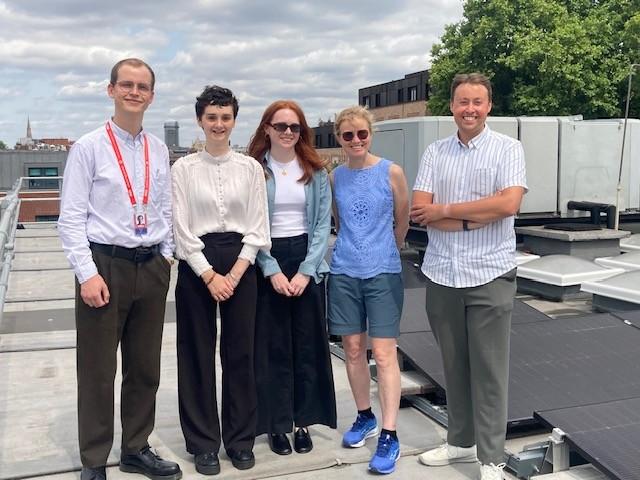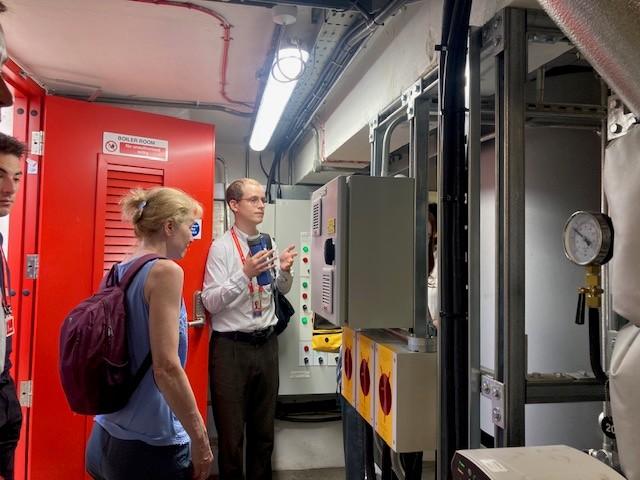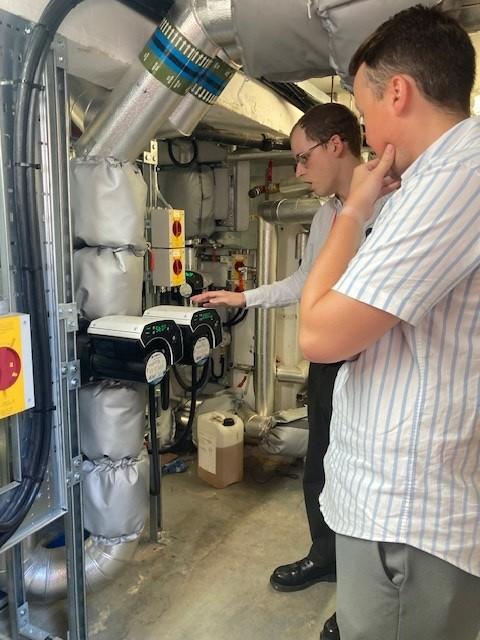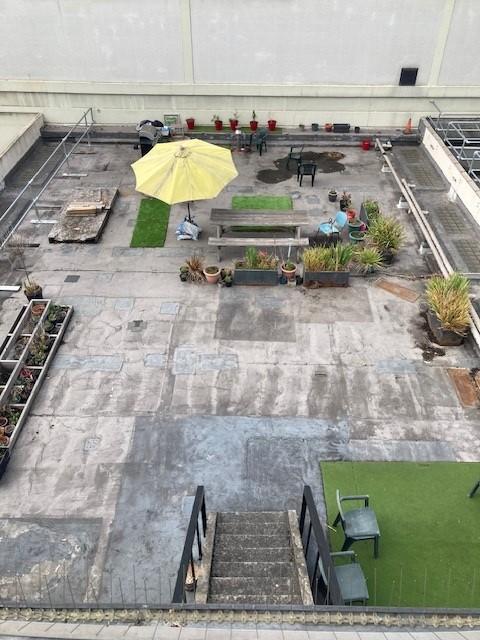Joining firefighters on their net zero journey
Team at Chelsea Fire Station celebrates major energy efficiency measures thanks to Public Sector Decarbonisation Scheme funding
Every day our London firefighters are working to keep people safe.
However, the service is also focused on keeping us all safe for tomorrow.
Our Salix team went along to Chelsea Fire Station, Kings Road, London, to see how London Fire Brigade (LFB) is working towards making our planet a healthier place to protect the generations to come.

As part of its energy efficiency works, Chelsea Fire Station has installed solar panels on its roof.
Pictured from left: George Gray, London Fire Brigade carbon reduction strategy manager, Evelyn West and Jude Bywater from Salix Finance, with Tricia Allen and Lloyd Ross from the Department for Energy Security and Net Zero
Photo credit: Salix Finance
We’ve been working with the LFB over the last few years to help it achieve its net zero carbon emissions goals. Their energy efficiency work includes the replacement of end-of-life fossil fuel boilers.
The service was able to tap into Public Sector Decarbonisation Scheme Phase 3b funding at Chelsea Fire Station to install new air source heat pumps and solar PV.
The LFB was awarded around £1.4 million through the fund for a project worth £4.3 million.
This was used across five sites: Bethnal Green Fire Station, Chelsea Fire Station, Edmonton Fire Station, Hainault Fire Station and Islington Fire Station.
The LFB also received Phase 3C funding across nine further fire stations.
More recently, it was successfully awarded Phase 4 funding under the scheme. Work on both schemes are underway.
We went along to talk to the service about what the energy efficiency measures meant to them and how it plans to move forward with the latest funding award.

George Gray, London Fire Brigade carbon reduction strategy manager explains how the new heating system works to Tricia Allen from the Department for Energy Security and Net Zero
Photo credit: Salix Finance
London Fire Brigade carbon reduction strategy manager George Gray said: “We are very proud of what we have achieved here.
“We have demonstrated that we can reduce our dependency on gas without impacting our core operation - all of our fire stations remained operating 24/7 throughout the project.
“We are looking forward to starting on the next stages of this project.”
Works at the site have included two large heat pumps and the solar PV, placed conveniently on the large flat roof. These have been operational since December.
During our visit we were able to access the roof to see the solar panels and take a close up look at the heat pumps and boiler room.
We have demonstrated that we can reduce our dependency on gas without impacting our core operation - all of our fire stations remained operating 24/7 throughout the project.

During the visit, we got a chance to see close-up how the power connections operate. Pictured, George Gray, London Fire Brigade carbon reduction strategy manager explains the system to Lloyd Ross from the Department for Energy Security and Net Zero
Photo credit: Salix Finance
For the LFB, other works have included increasing electrical capacity at fire stations to support the transition to electric vehicles and other electrical equipment.
Technologies installed include air source heat pumps, cavity wall insulation, Building Energy Management System, solar PV, double glazing, LED lighting and electric ovens.
During our visit to Chelsea, we heard how the project has gone relatively smoothly with the main issues around hard timescales.
London Fire Brigade Head of Carbon Reduction Paul Cook said: “This is a big step forward in our journey to becoming net zero.
“We play an important role in London's ambition to become a carbon net zero city. As global temperatures continue to rise, LFB has become increasingly conscious of the impact climate change adaption has and how we respond to - the risk of wildfires in London for example.
“By using renewable energy to power vital frontline services for Londoners and better protect our environment, we can make London a greener, safer, fairer and more sustainable city for all Londoners."

During our visit to Chelsea Fire Station, we got a chance to look at part of the roof which is used by the firefighters as a garden area. The plan for the future is to create a scenic rooftop garden.
This area can be enjoyed by firefighters after their busy shifts as well as providing a hub for nature.
Photo credit: Salix Finance
Our Salix project manager Evelyn West said: “It’s great to see a project that has had such a positive impact so quickly and ran smoothly.
“There have been tight timescales and these have been challenging, but big congratulations to the team.
“It’s lovely to visit Chelsea Fire Station and see the technologies in place.”
The LFB has 102 stations with a strong vision on modernising its sites.
Thank you to LFB for hosting our team during the visit and sharing your ambition, knowledge and learning.




